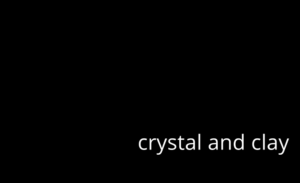sophie anne edwards
Crystal + clay documents a conversation with forming ice, and with clay sourced from the Kagawong River. The clay was formed into a tablet; the alphabet was marked into the semi-dry clay numerous times, then left under the waterfall. The alphabet was also typed dozens of times onto a strip of cotton and hung from a cedar tree overhanging the River, as a gesture toward ice forming language, to language crystallizing like ice.
This videopoem is part of a three year durational engagement with a local ecosystem that poses questions about language, the boundaries of authorship and readership, the possibility of collaboration with the more-than-human. Over several years the artist/author spent time on the Kagawong River, learning to listen and follow the rhythms and patterns of the flora, fauna, the weather and the water. In response to her observations, she installed a series of paper and wooden alphabets to act as invitations for various ‘agents’ – woodpeckers, otters, currents, ice, grasses – to edit, compose, re- and decompose. Some of these poems changed and disintegrated in a few seconds, others morphed over months.
The alphabets became a code for language, for translation, for a third space between the author’s settler language and the languages of the River ecosystem, allowing the author to hear differently and mitigate the grief and frustrations she encountered as a settler, a human, and someone with a limited biological vocabulary in the face of the dynamic languages of an ecosystem, and in the context of climate change.
At heart, the work asks whether leaving behind known and dominant languages and learning to listen might engender new forms of language and longing. Might new relationships emerge from a different way of seeing, feeling, hearing, and writing the world? Is there an in-between space between human and ecosystem languages?
This durational project was published by Talonbooks (2024) under the title Conversations with the Kagawong River. The experimental visual poems are contextualized by journalistic entries that follow the author’s sensory, bodily relations to the River, along with erasures, cut ups and layerings that reveal the historical and colonial histories and processes that have been invisibilized. Supported by local elders, language speakers and historians, the book highlights Mnidoo Mnising | Manitoulin Island Treaty history, an Anishinaabemowin river glossary and reproduces the Indigenous historical plaques installed throughout the Billings Township and along the Kagawong River. Conversations with the Kagawong River was included on the fall CBC Books to Watch List, as well as both CBC’s and Quill & Quire’s Most Anticipated Release lists. Poet Don McKay (two-time GG winner, wrote:
“Subversive, risk-taking, restlessly immersive, Sophie Anne Edwards’ Conversations with the Kagawong River presents an ecological practice of radical site-specific engagement. Driven by a desire to “fill language with the body,” and informed by local Anishinaabe and settler history, she brings to these encounters with the river an ontological urgency and fierce energy. Here is a bold category-crossing work to cherish and also heed.”
Link: https://vimeo.com/456358743?share=copy
Password: River



